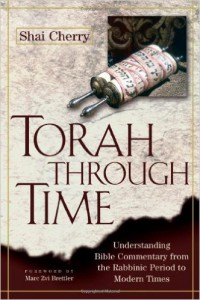[First posted September 27,2012, reposted January 4, 2014. The opening excerpt of this featured book is:
The truth, and therefore our understanding of God’s Will as expressed in the Torah, grows over time.
We have often emphasized in this website that it is not YHWH’s TRUTH or REVELATION that is progressive; rather it is OUR understanding of it that should progress, if we relentlessly read, study, mull over, chew, digest and never stop learning. If getting healthy requires eating the right kind of nutritional food, becoming wise requires spending time filling our minds with the only spiritual food ever dispensed by the Revelator: His TORAH. Indeed, as the author of this featured book aptly chose his title, the TORAH is understood progressively through time.
Another point we have insisted upon in our articles:
“Revelation, like the sun, is universally accessible.”
In our computer age when information is easily accessed by the click of a finger, there is no more reason to be ignorant of anything under the sun; ‘FYI’ is readily available and accessible, ready or not, care to read or not. So hey, indulge! but be discerning and expose your mind to all views, but choose and chew before you digest.
Here is the original introduction we wrote when this was first posted on September 27,2012:
“These are excerpts from the EPILOGUE of the book from which we featured excerpts covering Rabbinic interpretation of “How is man in God’s Image or Likeness?”
The book’s title: Torah Through Time: Understanding Biblical Commentary, from The Rabbinic Period to Modern Times, by Rabbi Shai Cherry. Reformatted and highlighted for easier reading and better comprehension.—Admin 1.]
——————————————
The truth, and therefore our understanding of God’s Will as expressed in the Torah, grows over time.
As Abraham Joshua Heschel wrote,
“The Bible is a seed, God is the sun,
but we are the soil.
Every generation is expected to bring forth new understanding and new realization.” Why? Because, as every good vintner knows, soil changes according to time and place, and we never know prospectively which combination will yield a quality vintage.
For Heschel, the Torah is a seed, not a tree.
A fig tree produces figs, whether now or later.
But the grape produced from the seed has been affected by the changing soil so that the next generation of seed is unlike its immediate predecessor.
The soil affects the seed. This botanical metaphor is radically evolutionary.
The context changes the meaning, which changes the subsequent context, which changes the subsequent meaning, and so on.
In Heschel’s analogy, we are the soil.
And we are a combination of history and hermeneutics, of historical context and textual interpretation.
The creation of humanity recounted in Genesis 1, initially, meant something very different than how Jews have come to read that story in the wake of its placement as the “introduction” to the creation of humanity of Genesis 2.
Similarly, the three different law codes related to the Hebrew slave likely possessed different legislative intent until the biblical redactor placed them in the same text.
Moreover, as we read these texts in later historical contexts wherein there is discomfort with patriarchy and slavery, a different soil from which they may have been originally written, the yield is affected.
The midrashic readings of the early Rabbis represent the next soil of interpretive context for Rabbinic Jews and produced the seeds for generations of gardens.
My primary goal in Torah through Time has been—-
- to educate tasters about the seeds and the soils,
- that is, the peculiarities of the Hebrew Bible
- and the idiosyncracies of its commentators.
- Our desired byproduct has been—
- to illustrate how a religious tradition justifies its claims that its Scripture is a tree of life (Prov. 3:18)
- and not petrified wood.
- My second purpose in Torah Through Time has been—
- to exhibit some of the gems of Torah commentary
- and to provide a map for those who seek to return.
Continuous revelation allows God’s light to shine on the descendants of Moses at an angle that allows us glimpses of God’s Torah that Moses himself could not perceive.
- “Had God revealed to the Israelites all of His goodness at once, they’d have died . . . .
- So God reveals to them bit by bit . . .
- only the slave abdicates responsibility to listen to those intimations of revelation.
Finally, though more of a hope than a goal, Torah Through Time seeks to rouse its readers to join the tradition of Torah commentary. . . .
- The Torah is too valuable to be left in the hands of any small group;
- it needs broad participation.
The Rabbis of Exodus Rabbah suggest—
- that everyone, alive and not-yet-alive, experienced revelation at Sinai—
- and the Rabbis of the Talmud go so far as to suggest that revelation was simultaneously broadcast in all languages.
In less mythical terms, revelation, like the sun is universally accessible.
If we are to heed the angels’ demand—
- to grow Truth from the ground,
- to bring forth new understandings
- and new realizations of God’s will,
- to hear and respond to those intimations of revelation,
—– it will require a collective effort.

